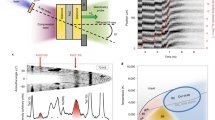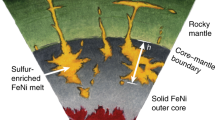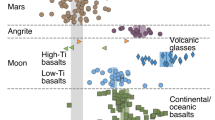Abstract
The tungsten isotope composition of meteorites indicates that core formation in planetesimals occurred within a few million years of Solar System formation1,2. But core formation requires a mechanism for segregating metal, and the ‘wetting’ properties of molten iron alloy in an olivine-rich matrix is thought to preclude segregation by permeable flow unless the silicate itself is partially molten3,4,5. Excess liquid metal over a percolation threshold, however, can potentially create permeability in a solid matrix, thereby permitting segregation. Here we report the percolation threshold for molten iron–sulphur compounds of approximately 5 vol.% in solid olivine, based on electrical conductivity measurements made in situ at high pressure and temperature. We conclude that heating within planetesimals by decay of short-lived radionuclides can increase temperature sufficiently above the iron–sulphur melting point (∼1,000 °C) to trigger segregation of iron alloy by permeable flow within the short timeframe indicated by tungsten isotopes. We infer that planetesimals with radii greater than about 30 km and larger planetary embryos are expected to have formed cores very early, and these objects would have contained much of the mass in the terrestrial region of the protoplanetary nebula. The Earth and other terrestrial planets are likely therefore to have formed by accretion of previously differentiated planetesimals, and Earth's core may accordingly be viewed as a blended composite of pre-formed cores.
This is a preview of subscription content, access via your institution
Access options
Subscribe to this journal
Receive 51 print issues and online access
$199.00 per year
only $3.90 per issue
Buy this article
- Purchase on Springer Link
- Instant access to full article PDF
Prices may be subject to local taxes which are calculated during checkout


Similar content being viewed by others
References
Yin, Q. et al. A short timescale for terrestrial planet formation from Hf–W chronometry of meteorites. Nature 418, 949–952 (2002)
Kleine, J., Munker, C., Mezger, K. & Palme, H. Rapid accretion and early core formation on asteroids and the terrestrial planets from Hf–W chronometry. Nature 418, 952–955 (2002)
Shannon, M. C. & Agee, C. B. High pressure constraints on percolative core formation. Geophys. Res. Lett. 23, 2717–2720 (1996)
Minarik, W. G., Ryerson, F. J. & Watson, E. B. Textural entrapment of core-forming melts. Science 272, 530–533 (1996)
Ballhaus, C. & Ellis, D. J. Mobility of core melts during Earth's accretion. Earth Planet Sci. Lett. 143, 137–145 (1996)
von Bargen, N. & Waff, H. S. Permeabilities, interfacial areas and curvatures of partially molten systems: Results of numerical computations of equilibrium microstructures. J. Geophys. Res. 91, 9261–9276 (1986)
Taylor, G. J. Core formation in asteroids. J. Geophys. Res. 97, 231–249 (1992)
Fei, Y., Bertka, C. M. & Finger, L. High-pressure iron-sulfur compound, Fe3S2, and melting relations in the Fe-FeS system. Science 275, 1621–1623 (1997)
Usselman, T. M. Experimental approach to the state of the core. Part I: The liquidus relations of the Fe-rich portion of the Fe-Ni-S system from 30 to 100 kb. Am. J. Sci. 275, 278–290 (1975)
Agee, C. B. Melting temperatures of the Allende meteorite: Implications for a Hadean magma ocean. Phys. Earth Planet. Inter. 100, 41–47 (1997)
Stevenson, D. J. in Origin of the Earth (eds Newsom, H. E. & Jones, J. H.) 231–249 (Oxford Univ. Press, Oxford, 1990)
Katsura, T., Sato, K. & Ito, E. Electrically conductivity measurement of minerals at high pressures and high temperatures. Rev. High Press. Sci. Technol. 7, 18–21 (1998)
Jurewicz, S. R. & Jones, J. H. Preliminary results of olivine/metal wetting experiments and the direct measurement of metal phase interconnectivity. Proc. Lunar Planet. Sci. Conf. 26, 709–710 (1995)
Gaetani, G. A. & Grove, T. L. Wetting of mantle olivine by sulfide melt: implications for Re/Os ratios in mantle peridotite and late-stage core formation. Earth Planet. Sci. Lett. 169, 147–163 (1999)
Scott, E. R. D., Love, S. G., Krot, A. N. in Chondrules and the Protoplanetary Disk (eds Hewins, R. H. et al.) 87–96 (Cambridge Univ. Press, Cambridge, 1996)
Wetherill, G. W. Provenance of the terrestrial planets. Geochim. Cosmochim. Acta 58, 4513–4520 (1994)
Hutcheon, I. D. & Hutchinson, R. Evidence from the Semarkona ordinary chondrite for 26Al heating of small planets. Nature 337, 238–241 (1989)
Shukolyukov, A. & Lugmair, G. W. Live iron-60 in the early solar system. Science 259, 1138–1142 (1993)
Shukolyukov, A. & Lugmair, G. W. 60Fe-60Ni systematics in the eucrite Caldera. Meteoritics 31, A129 (1997)
Taylor, S. R. Solar System Evolution: A New Perspective (Cambridge Univ. Press, Cambridge, 1992)
Weidenschilling, S. J. The origin of comets in the solar nebula: a unified model. Icarus 127, 290–306 (1997)
Kokubo, E. & Ida, S. Formation of protoplanets and planetesimals in the solar nebula. Icarus 143, 15–27 (2000)
Xu, Y., Poe, B. T., Shankland, T. J. & Rubie, D. C. Electrical conductivity of olivine, wadsleyite and ringwoodite under upper-mantle conditions. Science 280, 1415–1418 (1998)
Acknowledgements
We thank E. Ito, K. T. Koga and T. Hatakeyama for discussions; O. Nishikawa and C. Oka for technical assistance; and D. Kohlstedt and W. Minarik for comments and suggestions that improved the manuscript.
Author information
Authors and Affiliations
Corresponding author
Ethics declarations
Competing interests
The authors declare that they have no competing financial interests.
Supplementary information
Rights and permissions
About this article
Cite this article
Yoshino, T., Walter, M. & Katsura, T. Core formation in planetesimals triggered by permeable flow. Nature 422, 154–157 (2003). https://doi.org/10.1038/nature01459
Received:
Accepted:
Issue Date:
DOI: https://doi.org/10.1038/nature01459
This article is cited by
-
The Geochemical Legacy of Low-Temperature, Percolation-Driven Core Formation in Planetesimals
Earth, Moon, and Planets (2023)
-
Magma Ocean, Water, and the Early Atmosphere of Venus
Space Science Reviews (2023)
-
Early silicic magmatism on a differentiated asteroid
Nature Geoscience (2022)
-
Common feedstocks of late accretion for the terrestrial planets
Nature Astronomy (2021)
-
Reaction Infiltration Instabilities in Partially Molten Peridotite and Implications for Driving the Transport of Sulfide Liquid
Journal of Earth Science (2020)
Comments
By submitting a comment you agree to abide by our Terms and Community Guidelines. If you find something abusive or that does not comply with our terms or guidelines please flag it as inappropriate.



